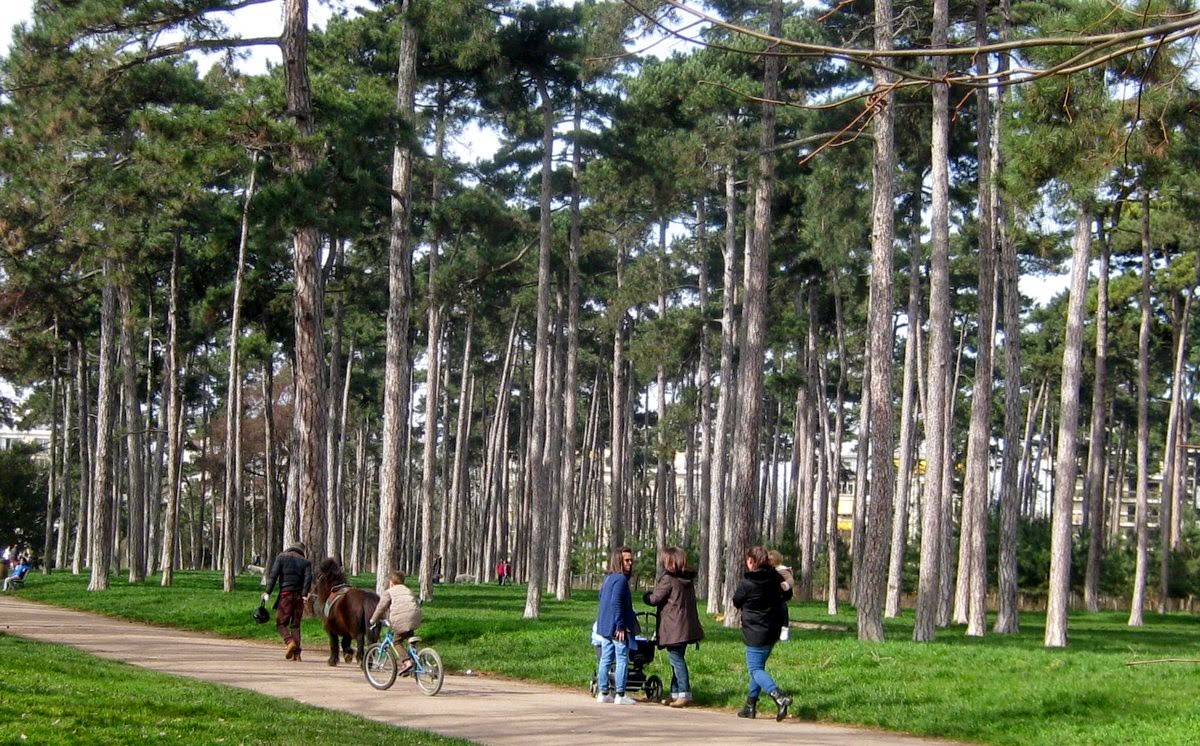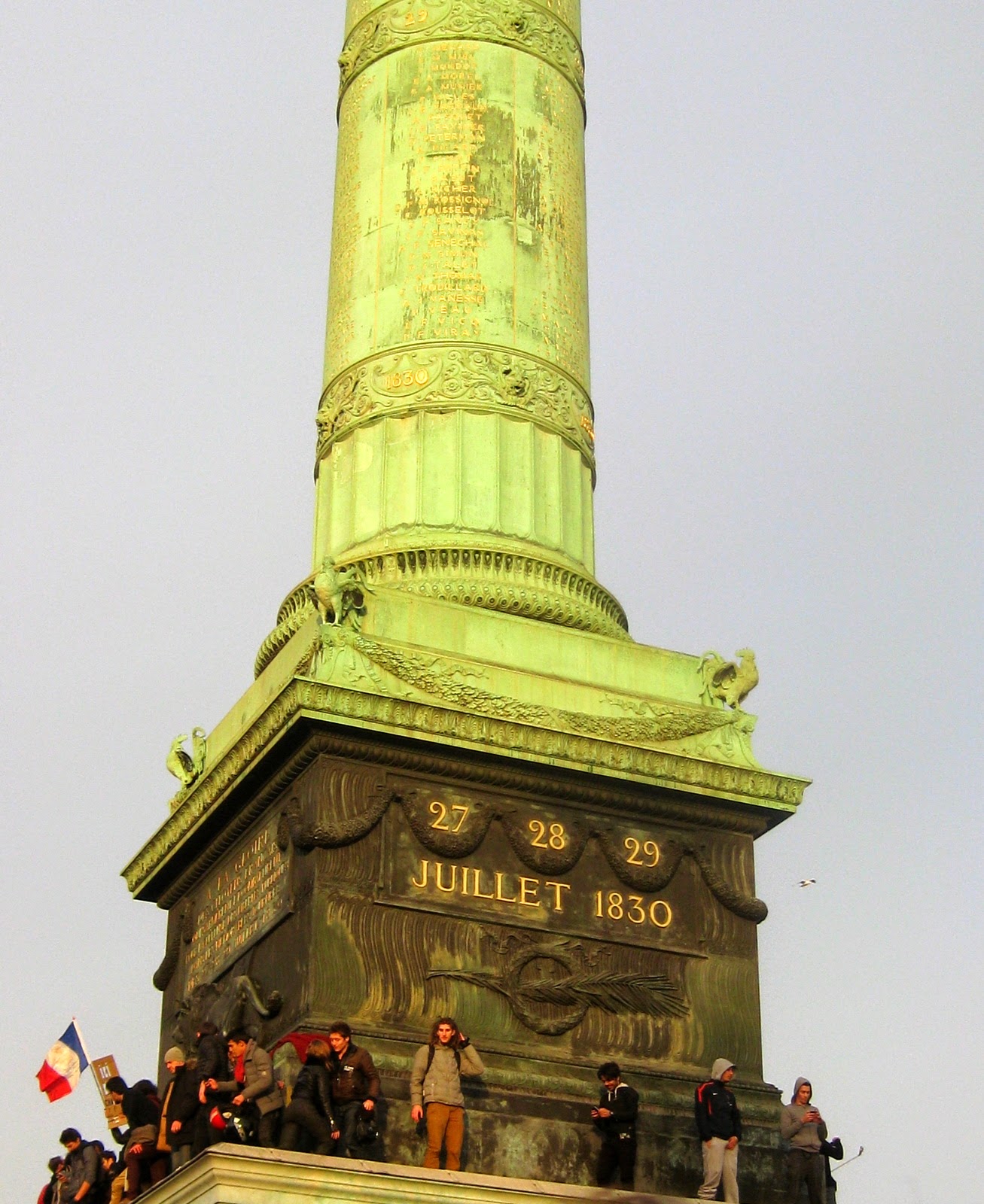Springlike weather arrived in Paris last weekend and with it came the urge to imitate Baudelaire's flâneur, strolling idly around Paris, watching people and admiring the city. Since this flâneur loves company, I invited JR to join me in my wanderings.
We cheated a bit by beginning our day not on foot, but on Line 1 of the metro. The city's first line, it opened in 1900 to take passengers to the various sites of the Exposition Universelle, the world's fair that was held that year in Paris. The line's present-day, 16.4 km length connects the 14th-century Chateau des Vincennes at its eastern end with the ultra-modern skyscrapers of La Defense at the western end. From our stop in the center of town, we took the line about half its distance to the Les Sablons stop, just outside the Bois de Boulogne. A former hunting ground for the kings of France, the Bois de Boulogne is now a wooded public park with miles of hiking, equestrian and bike trails. There are lakes, playing fields, picnic areas, children's playgrounds and the famous Autueil and Longchamp horse racing tracks.
The park's newest attraction is the Fondation Louis Vuitton, a private museum and cultural center that opened in 2014. Built by the luxury-goods company LVMH, it is one of only a handful of private museums in France. The building was designed by the architect Frank Gehry, whose works include among many others, the Guggenheim Museum in Bilbao and the Walt Disney Concert Hall in Los Angeles. Covered with 112 soaring, curved glass panels, the structure resembles an enormous, dreamlike sailboat. Its location at the extreme edge of Paris might seem an odd choice but, in fact, the company also owns the concessions of the nearby Jardin d'Acclimation, a children's amusement park. The garden, a modern masterpiece in its own time, was opened in the Bois de Boulogne in 1860 by the Emperor Napoleon III. A blending of the modernization of Paris by Baron Georges Eugene Haussmann and a growing public interest in zoology, it housed a large zoo among its other attractions.
By 11 a.m., the line to enter the museum was already long. Even with its beautiful, light-filled spaces, it was too nice a day to be inside so we decided to leave the interior visit for another time. Instead, we walked around the outside of the building to see it from different angles. Because of the many surrounding trees, it's difficult to get a view of the entire building from afar. As we strolled along one of the park's many paths, the gleaming manmade structure disappeared from view, giving way to the beauty of the forest.
From the park, we headed east into the high-rent, residential neighborhood of the 16th arrondissement. Originally made up of the rural villages of Auteuil and Passy, the area only became part of Paris in 1860 under the modernization project of the city by Napoleon III and Baron Haussmann. Since it was lunchtime, I consulted my downloaded version of the Paris guidebook, Les bonnes tables à petits prix. The guide, which was recommended to me by a friend, lists good, reasonably-priced restaurants all over Paris. It is published by the same group that produces the weekly journal L'Itinérant, which is sold on the streets of Paris by 700 venders, most of whom come from the City's homeless population. The same venders sell the restaurant guide, which is also available online. Among the 22 restaurants listed for the 16th, we chose Del Pappa on the avenue Malakoff. Not long afterward, we were seated at a lovely table by the window digging into a delicious pizza.
After lunch, we decided to walk down the Avenue de la Grande Armée until we were tired and then we could take the metro home. But who ever tires of Paris? The Avenue de la Grande Armée was created under the reign of Louis XV in 1668 to give the king a better view from his palace in the Tuileries. The only obstruction was a hill on the site of today's Place Charles deGaulle-Etoile. When you are king, however, all problems can be solved. The hill was removed and the king got a lovely 15-kilometer view into the surrounding countryside. Today that long view leads to the Grande Arche, with the modern skyscrapers of La Defense rising like Oz behind it. Fittingly, the avenue that once led to the wide open spaces is today lined with the headquarters of automobile and bicycle companies.
Next stop was the Arc de Triomphe, commissioned by the Emperor Napoleon in 1808 following his great victory at Austerlitz. Our route was the same one Napoleon took in 1810 when he entered Paris in triumph with his bride Marie Louise of Austria at his side. At that time, only the foundation had been built so Napoleon and Marie Louise passed under a wooden model that had been specially constructed for the occasion. Napoleon would never see the finished monument. He died in exile in 1821, 19 years before the Arc de Triomphe was completed. Today, the monument honors those who fought for France, especially in the Napoleonic wars. It also contains the Tomb of the Unknown Soldier from World War I, a war that killed approximately 1,350,000 French soldiers.
 |
| From the Daily Overview |
Borne along on this tidal wave of good cheer, we passed by the metro station at the Place de la Concorde and continued into the Jardin des Tuileries. The gardens were commissioned by Queen Catherine de Medici in 1559, and were used by royalty for several centuries before becoming public gardens at the time of the French Revolution. As we walked into the gardens, we saw that they had been taken over by another group of French royals - fashion models. Strolling about the gardens in impossibly high stilettos, the models, clad in the latest creations of the great fashion houses, were followed by hordes of photographers and spectators. We strolled in their wake, unobserved, which is just what a good flaneur should be.
By this time, we were only a mile or two from our apartment. Ahead of us lay the Louvre, Notre Dame and the Isle St. Louis. It was our last weekend in Paris for this year so we walked on, trying to savor it all.
To see more photos, click here.
A bientôt,
Geraldine

























